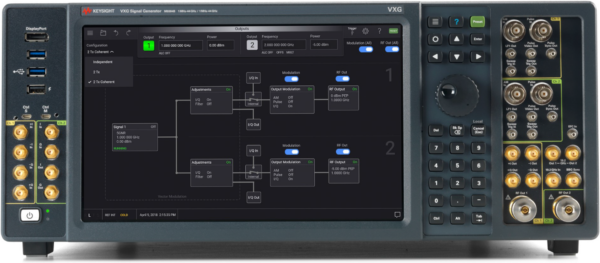Brought to you by Keysight Technologies
By Lawrence Liu
Consumer demand for more bandwidth, higher data transfer speeds, and better connectivity is pushing engineers to innovate the next frontier of cellular technology, using 5G NR to meet these demands with a reliable communication network.
With 5G NR, new and existing technologies must be utilised to achieve extreme data throughput while simultaneously introducing new test challenges: testing at millimetre-wave frequencies, wider channel bandwidths, and complex multi-antenna configurations.
5G NR mobile devices and base stations will implement sub-6 GHz and millimetre wave (mmWave) designs that require optimising and validating 3D beam performance with new, more complex over-the-air (OTA) test configurations with wide channel bandwidths and multi-channel MIMO test requirements.
This complexity increases the number of instruments needed, and measurement uncertainties in mmWave OTA systems, making it more difficult to achieve accurate and repeatable measurements.
But, even with the uncertainty of an evolving 5G New Radio standard, 5G has exciting applications across a variety of industries.
For automotive, autonomous vehicles’ response time to emergency situations are orders of magnitude faster than human response time. In entertainment and multimedia streaming across mobile phones and PCs, downloading the average length movie can decrease from seven minutes to six seconds. Finally, in IoT, 5G promises to increase security and health by enabling IoT devices with high data transfer speeds in the smart home.
However, to get there, 5G applications need to first jump over three challenging testing hurdles.
3 Key Challenges
Test System Setup Complexity
5G testing will generally require more complicated test setups to characterise new cellular designs. Early 5G applications will operate at sub-6 GHz and mmWave frequencies between 28 GHz – 39 GHz. 5G also requires higher modulation bandwidths (up to 2 GHz) to support peak data rates.
Since 5G applications operate at mmWave frequencies, previously conducted setups have transitioned to over-the-air test setups with phased array antennas.
These antennas bond directly to the RF integrated circuit (RFIC). They provide high gain and beam steering capabilities that enable higher reliability at mmWave frequencies.
Increased System Path Loss
Since the desired signal now propagates through air instead of a physical cable medium, there is some expected system path loss. High system path loss results in low signal-to-noise-ratio (SNR).
Low SNR causes transmitter measurements with poor error vector magnitude (EVM) and adjacent channel power ratio (ACPR). This means the measurements don’t show the real performance of a device, and it simultaneously reduces receiver sensitivity.
In today’s OTA world, everyone is familiar with the concept of radiated antenna testing. However, with the shift from 4G to 5G, OTA testing will also entail both RF parametric and functional performance tests at millimeter wave frequencies. These tests range from EVM and adjacent channel leakage ratio (ACLR) tests to modem and data throughput tests.
Long Product Development Cycles
Finally, another big testing challenge that the 5G NR standard introduces is an increased number of tests that must be conducted, which can lead to longer product development cycles.
This is partly due to instances where switching from two interference channel tests to dual channel MIMO and beamforming tests is not possible. It must also be kept keep in mind that with the new standard, there are more test items and scenarios that need to be validated.
The Solution
5G NR requires wider modulation bandwidth (2GHz) and operates at mmWave frequencies. Therefore, to test a receiver, a reliable signal generator is needed that meets those minimum requirements.
For the variety of 5G tests that need to be run, having multiple instruments is not the best solution. An instrument that performs all tests in one box will not only minimise test setup time but also help meet 5G 3GPP standards more quickly.

Compensating for excessive system path loss at mmWave frequencies requires a signal generator with high output power.
A signal generator must also have a linear output section, less distortion, and low phase noise at high power levels.
These are key to making accurate measurements at mmWave frequencies, and to ensure errors are not coming from the signal generator itself.
To overcome excess path loss, increasing the output power of a signal generator and using a highly sensitive signal analyzer, compensates for the loss.
Signal sources with built-in dual channels can enable easy testing of the multitude of 3GPP conformance tests configurations.
Software that has current 5G NR compliant signals allows product designers to focus on product development and not be sidetracked into spending it creating compliant signals.
Conclusion
5G NR technology is revolutionary. It will have a domino effect for other technology shifts as the cellular network provides more bandwidth, higher data transfer speeds, and better connectivity.
The opportunities that 5G will bring are limitless and will require the right tools to overcome the testing challenges of test system setup complexity, increased system path loss, and long product development cycles.
The right tools will not only help to stay ahead in the race to 5G, but also give higher confidence in device’s performance faster.
Lawrence Liu is general manager for Asia Pacific at Keysight Technologies






